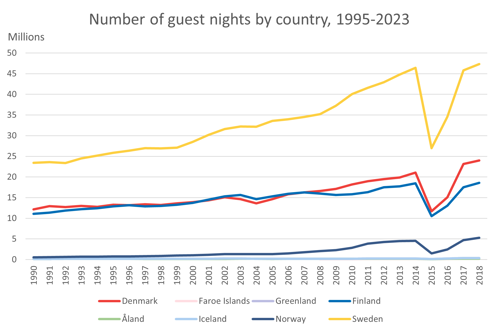Nordic tourism - recovery after the pandemic
Tourism in the Nordic region, measured in guest nights, had been growing for the past 30 years when the pandemic hit. Between 2019 and 2020, the number of nights spent in hotels with at least 10 beds dropped by almost 60 percent. However, in 2023 all 8 Nordic countries reported more guest nights than in any previous year.
Tourism plays an important role for a region because of its economic and employment potential, as well as its social and environmental implications. Tourism statistics are not only used to monitor the tourism policies but also its regional and sustainable development policies. [1]
Guest nights in the Nordic region
In 1995, a total of 62 million guest nights were reported from the Nordic countries, Faroe Islands excluded. [2] In 2019, the number was 116 million, meaning that the number of guest nights spent in a Nordic country had almost doubled over the period. Between 2019 and 2020, as a result of the pandemic, the number of nights spent in hotels with at least 10 beds dropped by 50 million, or 43 percent. The recovery was not immediate, but in 2023 a total of 121 million guest nights were reported, 4% more than in 2019.

Source: Nordic Statistics Database, TOUR03
Guest nights by country
Sweden has been the country with the largest number of guest nights during the whole period, up to double the number of Norway in second place. In 2023, Sweden reported 47 million guest nights while Norway reported 25 million. Denmark and Finland had very similar numbers during the first part of the period, but in the last ten years the number of guest nights in Denmark has increased at a higher rate, and the number is now close to that of Norway, 24 million compared to just under 19 million for Finland. Iceland has had the largest percentage increase, the guest nights in 2023 were 5.3 million, ten times the number in 1995. Faroe Islands and Åland have similar number of guest nights per year today, around 230,000, while Greenland have about 360,000.
Altogether, the Swedish share of the Nordic guest nights has been steady at around 40%. In the same way, the Danish share has been steady around 20%. For Finland and Norway, small decreases in the share can be seen over time, while the Icelandic share has grown. Of the guest nights reported in 2023, 21% were spent in Norway, 15% in Finland and 4% in Iceland. The three self-governing regions have a combined share of around 1%.

Source: Nordic Statistics Database, TOUR03
The effects of Covid-19 varied among the countries. Iceland reported the largest percentage decrease in guest nights between 2019 and 2020, 67%, followed by Åland, 56%. Denmark, Faroe Islands, Finland, Norway and Sweden all reported decreases in the 41 to 44% range, while Greenland had the smallest decrease with 34%.
All 8 countries have since had a similar pace of recovery. In 2021, the number of guest nights started to increase. Compared to 2020, they were up with between 11% (Norway) and 94% (Åland). In 2022 the increase continued, with between 31% in Åland and 91% in Iceland, when compared to 2021. The average increase was 47% both in 2021 and 2022. In 2023, the rate of the increase dropped to a more normal average of 3% compared to the previous year. Faroe Islands and Åland reported decreases, of 4% and 2%, respectively. Iceland again had the largest increase, with 12%.
In 2023 all 8 countries reported numbers higher than any previous year. Compared to 2019, the total number of guest nights increased by 4%.
______________________________________________________________________________________
[1] https://ec.europa.eu/eurostat/statistics-explained/index.php?title=Tourism_statistics
[2] No data was available for Faroe Islands in 1995. Data for Åland is available from 1995, but please note that Åland is also included in the data for Finland, for all years.
______________________________________________________________________________________